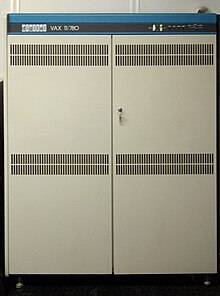Superminicomputer

A superminicomputer, colloquially supermini, is a high-end
16-bit systems that preceded them.[2][3] The development of these computers was driven by the need of applications to address larger memory.[1] The term midicomputer had been used earlier to refer to these systems.[4][5] Virtual memory was often an additional criteria that was considered for inclusion in this class of system.[6] The computational speed of these machines was significantly greater than the 16-bit minicomputers and approached the performance of small mainframe computers.[7] The name has at times been described as a "frivolous" term created by "marketeers" that lacks a specific definition. Describing a class of system has historically been seen as problematic: "In the computer kingdom, taxonomic classification of equipment is more of a black art than a science."[8] There is some disagreement about which systems should be included in this class. The origin of the name is uncertain.[1]
As technology improved rapidly the distinction between minicomputer and superminicomputer performance blurred.computer history.
Notable companies
Notable manufacturers of superminicomputers in 1980 included: Digital Equipment Corporation, Perkin-Elmer, and Prime Computer.[14][15] Other makers of systems included SEL/Gould and Data General.[16] Four years later there were about a dozen companies producing a significant number of superminicomputers.[17]

| Company | Percent |
|---|---|
| International Business Machines (IBM) | 41.9 |
| Digital Equipment Corporation (DEC) | 27.6 |
| Data General | 6.0 |
| Prime Computer | 5.6 |
| Perkin-Elmer, formerly Interdata | 3.4 |
| Wang Laboratories | 3.4 |
| Gould, formerly SEL | 2.6 |
| Hewlett-Packard | 2.2 |
| Honeywell | 2.2 |
| Harris Computer Systems | 1.7 |
| (other) | 3.4 |
Perkin-Elmer spun off their Data Systems Group in 1985 to form Concurrent Computer Corporation which continued making these systems. Nixdorf Computer, Norsk Data, and Toshiba also produced systems.[10]
Significant superminicomputers
- Interdata 7/32, 1974[3]
- Digital Equipment Corporation
- Prime Computer 750, 1979[20]
- Data General Eclipse MV/8000, 1980[21][B]
- IBM 4361, 1983[24]
- IBM 9370, 1987[12]
- ^ The VAX-11/780 was the standard by which the performance of other supermincomputers and small mainframes were compared.[7][18]
- ^ The design engineering of the Data General Eclipse MV/8000 was chronicled in The Soul of a New Machine by Tracy Kidder, a 1981 Pulitzer Prize winning book.[22][23]
External links
 The dictionary definition of superminicomputer at Wiktionary
The dictionary definition of superminicomputer at Wiktionary
References
- ^ a b c Connolly, James (September 30, 1985). "Superminis: Dynamic machines evolving to new uses". Computerworld. p. SR/4, SR10. Retrieved 5 December 2019.
No one can say with certainty who coined the word 'superminicomputer' and to what systems he meant it to apply, but consensus is emerging that a supermini is nothing more than a minicomputer — a high-end mini, but a mini nonetheless.
- S2CID 28156759.
- ^ .
Thirty-two-bit computing broke out of the mainframe category with the introduction of the 'supermini' Interdata 7/32 in the mid-1970s and then the VAX in 1977.
- ^ Yates, Edward H. (August 1980). Interrelationships of Technology, System Performance, and Prices for Mini/Midicomputers (PDF) (Report). Office of the Secretary of the Army. p. 3. Archived (PDF) from the original on December 14, 2019. Retrieved 14 December 2019.
- .
- Bibcode:1982caht.nasa..437S.
- ^ S2CID 27187801.
The manufacturers of the new processors all measure their machines against the venerable Digital Equipment Corp. VAX 11/780, which performs somewhat more than a million operations per second.
- ^ Stiefel, Malcolm L. (July 1978). "Superminis: What's In The Name?". Mini-Micro Systems. Vol. 11, no. 7. pp. 29–42.
At first blush, the word 'supermini' seems to be a contradiction in terms, like 'bittersweet.' There is a temptation to dismiss it immediately as a frivolous pun - the fruit a fertile Mad Ave. mind. In a sense, this gut reaction has merit; the term was obviously coined by marketeers to describe succinctly a class of machines without being too specific.
- ISBN 9780262264983.
As circuit densities and performance increased and prices dropped, the demarcation between minicomputers and superminicomputers and that between low and middle ranges of mainframes began to blur.
- ^ ISBN 9781483296197.
- S2CID 9058777.
- ^ S2CID 21352766.
- ^ "superminicomputer". Oxford English Dictionary. Oxford University Press. June 2012. 268008.
Now historical.
- S2CID 17187367.
- ^ Rosenberg, Ronald (30 Apr 1980). "Unveiling a 'supermini'". Boston Globe.
- ISSN 2053-7883. Retrieved 5 December 2019.
- ^ a b Davis, Bob (22 Jan 1985). "Prime Computer's New Model Heats Up Race To Construct the Fastest Superminicomputer". Wall Street Journal.
- ^ S2CID 34626939.
- ^ Rosenberg, Ronald (3 Mar 1983). "...'we never look over our shoulder' — Digital". Boston Globe.
- ^ "Firm's Sales on Rebound Thanks to Supermini". Computerworld. Jul 27, 1981.
- ^ Rosenberg, Ronald (2 Nov 1985). "Data General does it with class". Boston Globe.
- ISBN 978-3-319-77922-5.
- S2CID 5650132.
- ^ Rosenberg, Ronald (16 Sep 1983). "2 mid-sized computers are introduced by IBM". Boston Globe.
'They even called the new 4361 a multi-application superminicomputer, a term they never used before.'
